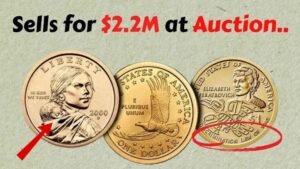Lincoln Wheat Penny Be Worth $200 Million: What if a penny in your pocket was worth $200 million? The Lincoln Wheat Penny, minted from 1909 to 1958, is famous for rare versions that collectors prize, like the 1943 copper penny. While no penny has ever sold for $200 million, some are worth millions, and they might still be hiding in your change or old jars. This article explains in simple words why these coins are valuable, how to spot them, and why the $200 million claim is likely a myth. Let’s start the hunt for these tiny treasures!
What Is the Lincoln Wheat Penny?
The Lincoln Wheat Penny, or Wheat Cent, was made by the U.S. Mint from 1909 to 1958 to honor President Abraham Lincoln. Designed by Victor David Brenner, it shows Lincoln’s face on the front and two wheat stalks on the back. It was the first U.S. coin to feature a real person’s portrait. Most are worth just a cent, but rare ones with errors or low mintage can fetch thousands or millions.
Why Are Some Pennies So Valuable?
Certain Wheat Pennies are worth a lot because of minting mistakes, rare years, or limited production. For example, a few 1943 pennies were made in copper by mistake during World War II, when pennies were supposed to be steel. These are super rare. The $200 million claim seems to be an online exaggeration, as the highest sale was $1.7 million for a 1943 copper penny in 2010.
Debunking the $200 Million Myth
No Lincoln Wheat Penny has ever been valued at $200 million. The highest recorded sales are for the 1943 copper penny, which sold for $1.7 million, and some experts estimate a perfect one could reach $2–$3 million. The $200 million figure likely comes from social media hype or confusion about the total value of all Wheat Pennies minted (over 27 billion coins). Still, rare pennies are worth searching for!
Key Rare Lincoln Wheat Pennies to Find
Here are the top Wheat Pennies collectors want in 2025:
1. 1943 Copper Penny
- Why Rare: Most 1943 pennies were steel to save copper for the war, but a few copper ones were made by mistake. Only about 20 exist.
- How to Spot: Check “1943” and test with a magnet—if it doesn’t stick, it’s copper.
- Value: Up to $1.7 million.
2. 1909-S VDB Penny
- Why Rare: Only 484,000 were minted in San Francisco with the designer’s “VDB” initials.
- How to Spot: Look for “1909-S” and “VDB” near the wheat stalks.
- Value: Up to $100,000 in top condition.
3. 1955 Doubled Die Penny
- Why Rare: A minting error doubled the text, like “LIBERTY” or the date.
- How to Spot: Check “1955” for blurry, doubled letters.
- Value: $1,000–$15,000.
4. 1914-D Penny
- Why Rare: Only 1.2 million were made in Denver.
- How to Spot: Look for “1914” and a “D” mint mark.
- Value: Up to $159,000 in mint condition.
| Coin Type | Year | Key Feature | Estimated Value |
|---|---|---|---|
| Copper Penny | 1943 | Copper, non-magnetic | Up to $1.7 million |
| VDB Penny | 1909-S | “S” and “VDB” on back | Up to $100,000 |
| Doubled Die Penny | 1955 | Doubled text on front | $1,000–$15,000 |
| Denver Penny | 1914-D | “D” mint mark | Up to $159,000 |
How to Check Your Pennies
To find a rare Wheat Penny:
- Check the Date: Look for 1909, 1914, 1943, or 1955.
- Find Mint Marks: Look for “S” (San Francisco) or “D” (Denver) below the date.
- Test 1943 Pennies: Use a magnet—copper doesn’t stick, steel does.
- Look for Errors: Check for doubled text or unusual marks.
- Inspect Condition: Shiny, unworn coins are worth more.
Where to Find These Coins
You might find Wheat Pennies in:
- Pocket Change: Some still circulate, though it’s rare.
- Bank Rolls: Ask for penny rolls at your bank.
- Old Jars or Collections: Check family heirlooms or coin stashes.
- Coin Shops or Markets: Visit dealers or check eBay.
What to Do If You Find a Rare Penny
- Don’t Clean It: Cleaning reduces value. Keep it as is.
- Store Safely: Use a plastic coin holder to protect it.
- Get It Graded: Services like PCGS or NGC can verify and value it.
- Sell Wisely: Try auction houses (Heritage Auctions), dealers (APMEX), or eBay with clear photos.
Avoiding Fakes
Fake pennies, like 1943 steel coins coated with copper, are common. Test 1943 pennies with a magnet—real copper ones don’t stick. Look for clear details and correct weight (3.11 grams for copper). Get professional grading to confirm authenticity.
Conclusion
The $200 million Lincoln Wheat Penny is likely a myth, but coins like the 1943 Copper Penny or 1909-S VDB are worth thousands or millions. These pennies, made from 1909 to 1958, could be in your change, old jars, or family collections. Check dates, mint marks, and test for copper, then get any finds graded by experts. The hunt for these rare coins is exciting, and you might find a small fortune. Start looking through your pennies today!
FAQ
Is there a $200 million Lincoln Wheat Penny?
No, it’s a myth. The highest sale was $1.7 million for a 1943 copper penny.
Which Lincoln Wheat Pennies are the most valuable?
The 1943 copper penny, 1909-S VDB, 1955 doubled die, and 1914-D are top picks.
Are rare Wheat Pennies still in circulation?
Yes, some can be found in pocket change, bank rolls, or old collections, but it’s rare.
How do I check if my penny is valuable?
Look for 1909, 1914, 1943, or 1955, check mint marks, test 1943 coins with a magnet, and look for errors.
What should I do if I find a rare penny?
Don’t clean it, store it in a coin holder, get it graded by PCGS or NGC, and sell through auctions or dealers.



